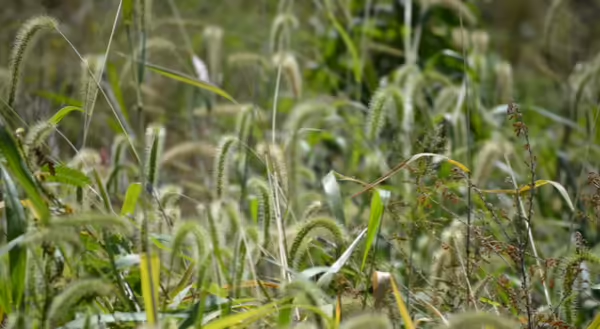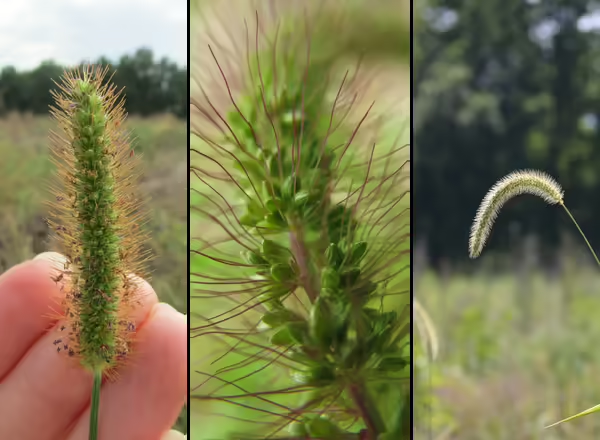
As we reach mid-July, the foxtail grasses have started to flower. Named for the appearance of their spike inflorescences, these grasses are easy to pick out from the crowd.
There are six species of foxtails in Illinois, but three of them are very common, found in every county in Illinois. All three of them are non-native, annual grasses that produce their spikelets in the summer. They are typically found growing in disturbed habitats. Giant, Yellow, and Green Foxtail are the grasses you are likely to encounter. What do they look like and how can you tell them apart from one another?
Size
Giant Foxtail (Setaria faberi) is the largest of the three, growing between two and four feet tall. Yellow Foxtail (Setaria pumila) grows one to three feet tall, with Green Foxtail (Setaria viridis) shorter, one to two feet tall.

Ligules and leaves
All three foxtails have ligules made up of stiff hairs. The leaves of Giant Foxtail will be broader than those of yellow and green, up to 3/4” across compared to less than ½” across of the other two. The presence or absence and type of hairs found on the leaf blades can help you distinguish the three species. You can find small, short hairs along the upper surface of the leaf blades of Giant Foxtail. Yellow Foxtail has long hairs near the base of the leaf blade, in the collar region (where the leaf blade becomes the sheath). Green Foxtail leaves are hairless.

Inflorescences
If you catch them with their inflorescences, telling them apart is pretty straightforward. The three foxtails have spike inflorescences, with their spikelets surrounded by bristles. Bristles are different than awns – while awns emerge from the tip of the spikelets, bristles surround the base of the spikelet, and are found in clusters.
There are two characteristics of the inflorescences that I use to tell them apart. First, the spike of Giant Foxtail curves downward as it matures, while those of yellow and green will usually remain erect. The second is to count the number of bristles surrounding each spikelet. Giant and Green Foxtail have 1 to 3, while Yellow Foxtail has between 5 and 15 bristles. Putting those characteristics together, Giant Foxtail has a nodding inflorescence with bristles in clusters of 1 to 3, Green Foxtail has an erect inflorescence with bristles in clusters of 1 to 3, and Yellow Foxtail has an erect inflorescence with bristles in clusters of 5 to 15.
What about color?
With words like yellow and green in the names, you’re probably wondering why I didn’t mention colors of the grasses as an identification characteristic – that’s because there’s a fine line between green and yellow when it comes to grasses. Young foliage can tend to be on the green side while old and weathered foliage typically takes on a yellow appearance. One distinguishing color characteristic is that the bristles (just the bristles, not the spikelets themselves) of Green Foxtail are sometimes purple (otherwise green), while the other two foxtail bristles are yellow to tan in color. I use the leaf hairiness and bristle number characteristics to tell these grasses apart as I find them much more reliable indicators than color.
Do you have foxtail on your property? University of Minnesota Extension has management recommendations for all three foxtails.
Never miss a new post! Sign up for our email list.
ABOUT THE AUTHOR: Erin Garrett is a Natural Resources, Environment, and Energy Educator for University of Illinois Extension serving Alexander, Johnson, Massac, Pulaski, and Union counties. Erin develops and delivers high impact programming to adults and youth to help them develop an appreciation for natural resources and to empower them to make small changes to positively impact the environment. Erin’s programming focuses on why homeowners should consider choosing native plants, how to support native pollinators, how to identify grasses, how to identify and manage invasive species, and developing an appreciation for prairie ecosystems.
ABOUT THE BLOG: Grasses at a Glance dives into grass identification, focusing on tips and tricks that make grass identification possible. Get information about native and non-native species, how to tell look-alikes apart, and which grasses you can find in Illinois.